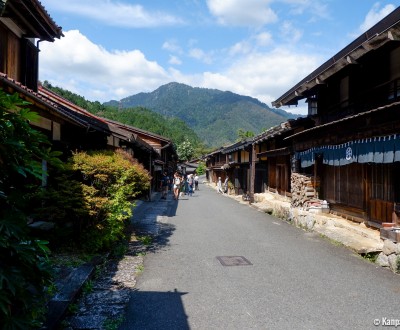Nakasendo Trail
Hiking through the Kiso Valley from Magome to Tsumago
Nakasendo is an old road through the Japanese Alps that once connected Tokyo with Kyoto during the Edo Period (1603-1863). Along the 550-kilometers race route, approximately 69 stage cities welcomed travelers to rest. Today, there is a well-maintained section of the former road about 8 kilometers long between the Magome-juku and Tsumago-juku stations. Located in the Kiso Valley and loved by tourists, it is commonly called the Nakasendo Trail.
Going to the Japanese Alps requires a detour through the mountains, which are usually less accessible than the coastal areas. Visiting these locations is worth the effort, especially for the Nakasendo hiking trail located in the heart of the Kiso Valley in the Gifu Prefecture.
Arriving from Nagoya, we start the walk at Magome-juku, the 43rd station on the Nakasendo Trail, until reaching Tsumago-juku, the 42nd village. Depending on the rhythm of your walk, a leisurely pace for amateurs is about three to five hours of walk and requires an adequate pair of shoes.

Departure from Magome
Magome has the charming character of an old postcard landscape, where the buildings, as well as the paved roads, carry the visitors into another era, one that is more authentic and farther away from modern urbanization. Its steep trails are reminiscent of the kanji characters chosen for the name of the station, which mean 馬 "horse" and 籠 "basket." The road used to be so hard that it was said horses had to stop at the guesthouse.
Along the preserved central hub of this small city, we discover old watermills, historical museums, traditional shops, restaurants, and charming cafes, including some offering superb views of the Kiso Valley. At the end of the main road, a panoramic view allows you to contemplate the surrounding landscape leading up to Mount Ena. If you sleep in the city, it is recommended that you view the sunrises and sunsets.
There is a low risk of misleading information, as this "lost" village is very well indicated thanks to numerous panels written in Japanese and English. There is even a tourist information center that provides paper maps to hikers going on safe adventures along the ancient road.

In a few minutes, the town vanishes and gives way to rural landscapes of forests and mountains. Now quite secluded, we can feel the mystical and historic atmosphere of these places that were formerly frequented. We also notice small bells on the road’s sides that, when rung, drive away neighboring black bears. This very Japanese precaution should not prevent anyone from hiking, as there is no real danger.
Several attractions are accessible on this section between Magome and Tsumago. For example, we can see the Odaki and Medaki Waterfalls, a 17th century familial residence of the Fujiwara clan, and a temple dedicated to the deity Koyasu Kannon. Seeing these sites may add two or three additional hours to the hike time. We recommend a stopover in the Tateba-jaya traditional tea house, where a cup of matcha is kindly served to travelers.

Arriving in Tsumago
Tsumago town is the end of the 8 kilometers walk on the Nakasendo Road. As charming as its colleague, the landscape is a little different in Tsumago. Again, we can easily find places to eat and shop for souvenirs. It is also possible to visit old stables or tour the interior of an old house and the local history museum.
While the hike is open year-round, we recommend tourists without the proper equipment avoid the winter when the snow covers the path. For the other seasons of fall 🍁, spring 🌸, and summer the mountain’s cooler weather is pleasant, and the Kiso Valley always displays beautiful backdrops for hikes. Also, Tsumago welcomes several annual festivals that brighten the scenery:
- Wachino Shrine Festival, July 23-24: a parade of mikoshi floats carried by young regional men.
- Fire Festival of Tsumago, the fourth Saturday in August: the city is illuminated by fire torches, and there are Kiso performances, a traditional dance by the inhabitants.
- Costumed Parade Bunka Bunsei, November 23: a traditional local parade that creates the former Edo ambiance.
This hike between Magome and Tsumago can be either a very long day excursion from Osaka or Kyoto or as a stopover on the road between these two tourist cities. Several accommodations are available in the valley. This section of the former road can also entice hikers to walk toward the other towns of the Nakasendo Trail.

